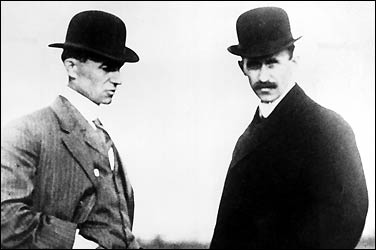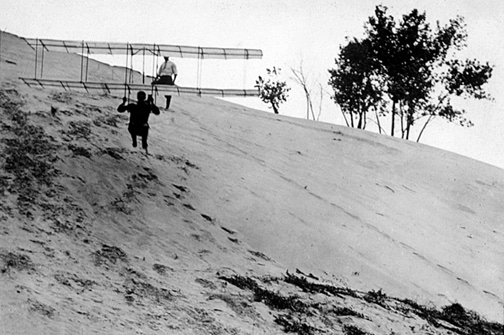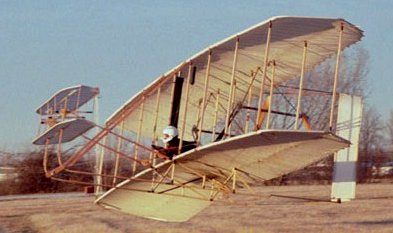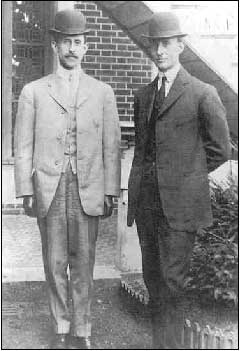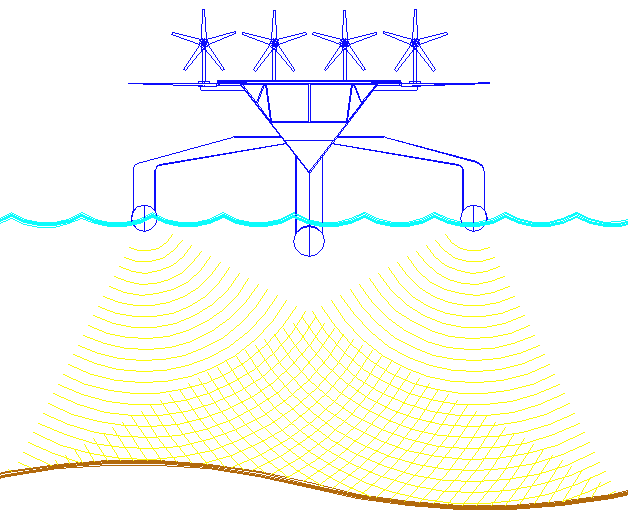|
ORVILLE and WILBUR WRIGHT
|
|||||||||||||||||||||||||||||||||||||||||
|
Wilbur and Orville Wright were two brothers from the heartland of America with a vision as sweeping as the sky and a practicality as down-to-earth as the Wright Cycle Co., the bicycle business they founded in Dayton, Ohio, in 1892. But while there were countless bicycle shops in turn-of-the-century America, in only one were wings being built as well as wheels. When the Wright brothers finally realized their vision of powered human flight in 1903, they made the world a forever smaller place. I've been to Kitty Hawk, N.C., and seen where the brothers imagined the future, and then literally flew across its high frontier. It was an inspiration to be there, and to soak up the amazing perseverance and creativity of these two pioneers.
The Wright brothers had been fascinated by the idea of flight from an early age. In 1878 their father, a bishop in the Church of the United Brethren in Christ, gave them a flying toy made of cork and bamboo. It had a paper body and was powered by rubber bands. The young boys soon broke the fragile toy, but the memory of its faltering flight across their living room stayed with them. By the mid-1890s Wilbur was reading every book and paper he could find on the still earthbound science of human flight. And four years before they made history at Kitty Hawk, the brothers built their first, scaled-down flying machine--a pilotless "kite" with a 5-ft. wingspan, and made of wood, wire and cloth. Based on that experiment, Wilbur became convinced that he could build an aircraft that would be "capable of sustaining a man."
Wilbur and Orville Wright
While the brothers' bicycle business paid the bills, it was Wilbur's abiding dream of building a full-size flying machine that inspired their work. For many years, he once said, he had been "afflicted with the belief that flight is possible." The reality of that obsession was a lonely quest for the brothers in the workroom behind their bike shop, plotting to defy gravity and conquer the wind. Yet that obsessive kind of world-changing belief is a force that drives you to solve a problem, to find the breakthrough - a force that drives you to bet everything on a fragile wing or a new idea. It was a force that led the Wright brothers to perfect controlled flight.
When published aeronautical data turned out to be unreliable, the Wright brothers built their own wind tunnel to test airfoils and measure empirically how to lift a flying machine into the sky. They were the first to discover that a long, narrow wing shape was the ideal architecture of flight. They figured out how to move the vehicle freely, not just across land, but up and down on a cushion of air. They built a forward elevator to control the pitch of their craft as it nosed up and down. They fashioned a pair of twin rudders in back to control its tendency to yaw from side to side.
They devised a pulley system that warped the shape of the wings in mid-flight to turn the plane and to stop it from rolling laterally in air. Recognizing that a propeller isn't like a ship's screw, but becomes, in effect, a rotating wing, they used the data from their wind-tunnel experiments to design the first effective airplane props--a pair of 8-ft. propellers, carved out of laminated spruce, that turned in opposite directions to offset the twisting effect on the machine's structure. And when they discovered that a lightweight gas-powered engine did not exist, they decided to design and build their own. It produced 12 horsepower and weighed only 152 lbs.
Around the turn of the century, dozens of people were working to invent the airplane. The period of active experimentation begins in 1891, when noted German engineer Otto Lilienthal began experimenting with hang gliders. Lilienthal took seriously the ideas advocated by Sir George Cayley almost a hundred years earlier. Through an extensive study of birds and bird flight, Cayley realized that the lift function and the thrust function of bird wings were separate and distinct, and could be imitated by different systems on a fixed-wing craft. Lilienthal began his work on heavier-than-air craft not by developing a complete airplane, but instead by focusing his efforts on a fixed-wing glider.
Lilienthal brought a much-needed respectability to the enterprise of inventing an airplane. Up to that point, efforts to invent airplanes were considered to be the province of crackpots and wild-eyed dreamers. But when a hard-headed German engineer entered the game, other respectable people were soon to follow.
In addition to the respectability he brought to the field, Lilienthal made two more important contributions to the nascent field of airplane invention: the style of perfecting a glider before attempting powered flight (which Gibbs-Smith refers to as the 'airman' approach), and a table of the lift provided by curved wings. Lilienthal was killed in a gliding accident August 10, 1896. Following in Lilienthal's footsteps, efforts to invent an airplane became commonplace in the 1890's. The majority of the efforts were in Europe, including Captain F. Ferber, Henri Robart, Solirene, Levavasseur, Clement Ader, Percy Pilcher, and Sir Hiram Maxim. In the U.S., prominent attempts were made by Octave Chanute and Samuel Pierpont Langley.
The Wrights began their efforts to invent the airplane by carefully studying what others had done before. They read everything they could get their hands on, including Octave Chanute's Progress in Flying Machines, the 1895, 1896, and 1897 volumes of the Aeronautical Annual, and popular articles in newspapers and magazines. It seems obvious to begin with a systematic study of past efforts, especially trying to understand the failures and limitations of previous work. Still, many never bothered to put in the effort; by ignoring the lessons of the past, they frequently suffered greatly. The Wrights took the time to do their homework. The brothers exhibited an unusual ability to judge the worth of ideas they read, discarding as useless some widely-held superstitions in the field, identifying the hard facts, and carefully integrating bits and fragments of knowledge scattered through the literature.
The Wrights followed the example set by Lilienthal and continued by Chanute of beginning with the glider. Only after they solved the problems of gliding flight did they feel it worthwhile to tackle the more difficult challenge of building a powered airplane. This decision was doubtless influenced by Chanute's arguments in Progress in Flying Machines, but Lilienthal and others also advocated the same approach. The Wrights also chose to pattern their aircraft after the Chanute-Herring biplane, a sturdy and relatively successful biplane glider. Lilienthal's data on the lift of wing surfaces were used in their design of the 1900 and 1901 gliders.
By careful study, the Wrights identified the best features of past aircraft and employed aeronautical theory about the lift of wings to design their first craft. Although it did not perform as expected, it was among the best gliders that had ever been built.
Though most Americans know something of that fateful December day in 1903, fewer are aware of the rivalry between the Wrights and another inventor/entrepreneur — one Samuel Pierpont Langley. A hundred summers ago, that rivalry was at fever pitch and no one could have guessed that two bicycle mechanics from Dayton, Ohio with high school educations would best the better-financed and aristocratic Langley.
Langley was already way ahead of the Wrights. A renowned astrophysicist, he was secretary of the respected Smithsonian Institution in Washington, D.C. As early as 1896, he had built and flown an unmanned “aerodrome” — a tandem-wing aircraft that utilized a lightweight steam engine for propulsion.
Both Langley and the Wrights had Smithsonian connections, but with a huge and perhaps decisive difference. For Langley, the Smithsonian was the conduit for a $50,000 federal grant, matched by the Institution, to finance his experiments (equivalent to about a million dollars in today’s purchasing power). In 1899, Wilbur Wright wrote a letter to the Smithsonian asking for nothing more than a reading list on flight. He and Orville would finance their dream with the nickels and dimes they could scrape together from the profits of their private business.
Wright Brothers - Flyer replica
The Design and Test Strategy of Invention
Once you have a design that is at least partially successful, a simple and self-evident strategy is to refine the design to make it better. This method is generally referred to as hill-climbing. Hill climbing is only possible when a designer can identify the specific strengths and weaknesses of an invention. Knowing that, it is a simple matter to preserve the strengths and improve upon the weaknesses, making the overall design better and better.
Most hopeful inventors employed the Design and Test strategy for invention. A new design was identified, the craft was constructed and then taken out to the field for testing. The results of the testing were used in making a new design, completing the loop.
Unfortunately, a field test does not reveal the specific strengths and weaknesses of a craft. When tested in the field, an inventor learns a few simple things about a craft. The inventor can easily measure how far the craft flew and how long it remained airborne. The inventor may get some feel for other aspects of the craft's performance, such as how sensitive it is to disturbances in the air, how responsive it might be to the pilot's control, and the like. Let us consider for a moment how an inventor might refine the airplane or design a new model using this information from a field test.
First, consider the value of objective numbers like time and distance in flight. These numbers are global performance metrics that reflect the properties of the craft as a whole, not specific features of the design. For example, a glider may remain in the air for only a short time because it does not have sufficient lift, or because it has too much drag. The inventor has no way of knowing which problem to work on. A powered plane may not have enough thrust, may not have enough lift, or may have too much drag. The global performance metrics are insensitive to the particular strengths and weaknesses of any particular design.
Subjective measures, like the 'feel' of the craft in flight, are even worse, because they are compounded by pilot error and the test circumstances. A craft tested on a calm day may seem to have sufficient control, but the revised version tested on a windy day will seem balky and troublesome. When the pilot makes a mistake, he may blame the craft, not his own actions.
Under the circumstances, inventors do not get useful information out of field trials that help them improve their design. Often times we find early models fly better than their successors, as inventors root out the good in their design, and leave more of the bad. This problem seems intrinsic to designs where the overall performance is a function of many elements and the only information obtained from tests are global performance metrics.
Doing It Wright
The Wrights found the trap door out of this unhappy method. Instead of designing and building whole craft, the two brothers constantly found ways to test individual components and subsystems of their designs. Early on, Wilbur realized that a plane could be controlled on its lateral axis (one wing tips up while the other tips down) if the wings of a plane were twisted, turning the craft into "an animated windmill." Instead of building an airplane with this design, the two brothers fashioned a 5-foot biplane kite. By flying the kite in the breeze, the two brothers were able to show that twisting the wings had the intended effect in causing the kite to roll.
The identification of an effective method of lateral control is universally recognized as being one of the most important contributions the Wrights made to aviation, and was the idea protected by their patent issued May 22, 1906. Thus, it may be somewhat surprising to learn that when the brothers tested their first glider in 1900, in Kitty Hawk, N.C., the controls for twisting the wings were tied off, preventing any testing of this important breakthrough. In 1900, the Wrights were not concerned with lateral control. They knew they had already solved the problem given their experience with the small kite. To fly, their craft had to generate sufficient lift, and this was the issue they were exploring in 1900. As Figure 3 shows, the Wrights often tested the 1900 glider as a kite, attempting to determine the amount of lift generated by the wings.
The 1900 glider did not produce as much lift as the Wrights predicted, on the basis of Lilienthal's tables, that it would. Unfortunately, they had designed the craft to be 18 feet wide, but were only able to find 16 foot spars at Norfolk, Virginia, on their way to Kitty Hawk, so they were unsure about whether the problem was the original design, or because they had to substitute shorter spars than their design called for. The two brothers built a new glider in 1901, this time obtaining the long spars in advance of their journey. The two brothers also realized they could not rely on the Kitty Hawk weather station for accurate statistics about wind velocity at their site, and so brought along an anemometer, so they could measure wind speed and the angle of attack of their craft, and obtain a reasonably- accurate estimate of the lift of the airplane. The 1901 glider conclusively demonstrated the lift of the airplane was not as great as the formula predicted. The two brothers realized they could not continue to build expensive gliders and convey them to Kitty Hawk for testing. Once again, they found a way to test a piece of the craft: they developed a state-of-the-art wind tunnel. Unlike previous wind tunnels, the Wrights created instruments that quantified the lift and drag of wing segments. They tested between 80 and 200 different wing shapes in their wind tunnel. In the process, they discovered the coefficient of lift (known as "Smeaton's coefficient") that was commonly accepted was wrong, and they also identified a highly-efficient wing shape in their tunnel.
This knowledge allowed the brothers to create the first effective heavier-than-air craft, the 1902 glider. Although the longest flight the glider was ever to make covered only 662 feet on the ground, it was flying into a stiff wind, and so was flying a much greater distance through the air. Had the brothers taken the trouble to launch their craft from a high cliff, or from a hot-air balloon, or tow it from an automobile or boat, the magnitude of their accomplishment in 1902 would be better understood.
At this point, the Wrights only needed to add a system of thrust to make a powered airplane. They developed a wonderful 4-cylinder gasoline engine, returned to the wind tunnel to test propeller shapes, and designed their 1903 craft. By the time they took the craft to Kitty Hawk, the two brothers knew it could fly. They had tested the horsepower of the engine, the thrust of the propellers, and knew their wings would provide sufficient lift. There was no guesswork in the 1903 trials - just a confirmation of something the Wrights already knew: They had built an effective airplane.
The Unhappy Ending
Although the Wrights initially received wide acclaim for their invention of the airplane, the aviation community was quickly overcome by jealousy and greed: airplane developers did not want to pay the modest license fee the Wright brothers asked when others employed their method of lateral control in heavier-than-air flight. To escape this fee, the aviation industry engaged in a prolonged smear campaign against the Wright brothers, minimizing their contributions in the invention of the airplane.
France and Germany simply refused to issue the Wrights patents for controlling the lateral motion of airplanes by ailerons or wing-warping. Europeans were free to copy the Wrights ideas without restrictions, or the embarrassing admission that the Wrights had done something the Europeans had not.
In America, an ugly patent fight erupted. The Wrights brought suit against Glenn Curtiss, who was selling airplanes with aileron control without paying royalties to the Wrights. To fight the suit, Curtiss enlisted Albert Zahm, then on the staff at the Smithsonian. Zahm, with his public forum through his position at the Smithsonian and later at the Library of Congress, was especially effective in trivializing the Wright's contributions.
Even the Smithsonian got into the fight, for selfish reasons. Samuel Pierpont Langley, one-time director of the Institution, had spent a fortune of the Institution's money to develop heavier-than-air craft. His craft, launched from a houseboat, could not take the strains imposed by the catapult, and broke during the launching, causing a great deal of humiliation to both Langley and the Smithsonian. Curtiss and Zahm offered to prove that Langley's airplane was effective, restoring the reputation of the Smithsonian in the process. They re-built the crashed airplane, making a number of modifications to the craft needed to make it airworthy. It was then flown in a straight line, with no method of lateral control, as a way of showing the Wrights did not really invent the airplane. In all the publicity that followed the event, the Smithsonian, Curtiss, and Zahm neglected to mention the many modifications made to the plane, claiming they had reconstructed the plane to Langley's original design. The Smithsonian recanted this claim only after many years and considerable damage to the Wright's reputation.
What reward did society bestow upon the Wrights for all their pains, their creativity, and their generosity? Wilbur, worn out and exhausted from a prolonged legal fight in the patent battle against a set of well-financed, viscous, and self-serving collection of airplane developers, succumbed to a mild case of food poisoning. In a small measure of victory, the courts sided with the Wrights. From this outcome, Orville was able to obtain a tidy sum of money, although the sum was in no way commensurate with the importance of the Wright's contribution or the patent the brothers received for their method of lateral control. Of course, no money at all came from European countries, which simply stole the Wright ideas without compensation.
The smear campaign against the Wrights must be counted as one of the most effective in history. Today the common man recognizes the Wrights as the inventors of the airplane, but the prevailing attitude toward the Wrights is that they were bicycle mechanics who invented, perhaps by happenstance and chance, the first airplane. Few today realize the genius and hard work the Wrights brought to their chosen task. Even fewer appreciate the elegance of the sturdy Wright biplanes, how difficult it is to learn to fly as you invent an airplane, or have any idea how much longer society would have waited for airplanes if the Wrights hadn't taught us all the way. As we near the 100th anniversary of the First Flight, efforts are underway to build a national park in Dayton to honor the Wrights. One might imagine that corporations who make billions off the airplane would be eager to support this effort. One might imagine that countries who stole from the Wrights might be looking to make amends. One would be wrong. Watch your back, Jack.
The Wright Brothers
The Wrights created one of the greatest cultural forces since the development of writing, for their invention effectively became the World Wide Web of that era, bringing people, languages, ideas and values together. It also ushered in an age of globalization, as the world's flight paths became the superhighways of an emerging international economy. Those superhighways of the sky not only revolutionized international business; they also opened up isolated economies, carried the cause of democracy around the world and broke down every kind of political barrier. And they set travelers on a path that would eventually lead beyond Earth's atmosphere.
The Wright brothers and their invention, then, sparked a revolution as far-reaching as the industrial and digital revolutions. But that revolution did not come about by luck or accident. It was vision, quiet resolve and the application of scientific methodology that enabled Orville and Wilbur to carry the human race skyward. Their example reminds us that genius doesn't have a pedigree, and that you don't discover new worlds by plying safe, conventional waters. With 10 years of hindsight, even Orville Wright admitted that "I look with amazement upon our audacity in attempting flights with a new and untried machine."
Now, on the eve of another century, who knows where the next Wright brothers will be found, in what grade of school they're studying, or in what garage they're inventing the next Flyer of the information age. Our mission is to make sure that wherever they are, they have the chance to run their own course, to persevere and follow their own inspiration. We have to understand that engineering breakthroughs are not just mechanical or scientific — they are liberating forces that can continually improve people's lives. Who would have thought, as the 20th century opened, that one of its greatest contributions would come from two obscure, fresh-faced young Americans who pursued the utmost bounds of human thought and gave us all, for the first time, the power literally to sail beyond the sunset.
The 20th century has been the American Century in large part because of great inventors such as the Wright brothers. May we follow their flight paths and blaze our own in the 21st century.
INVENTORS A - Z
The ultimate Robot Boat. Solarnavigator uses an advanced SWASSH hull as the platform to mount the world's first autonomous circumnavigation. A successful expedition could pave the way for improved safety at sea.
|
|||||||||||||||||||||||||||||||||||||||||
|
This website is copyright © 1991- 2013 Electrick Publications. All rights reserved. The bird logo and names Solar Navigator and Blueplanet Ecostar are trademarks ™. The Blueplanet vehicle configuration is registered ®. All other trademarks hereby acknowledged and please note that this project should not be confused with the Australian: 'World Solar Challenge'™which is a superb road vehicle endurance race from Darwin to Adelaide. Max Energy Limited is an educational charity working hard to promote world peace.
|
|||||||||||||||||||||||||||||||||||||||||
|
AUTOMOTIVE | BLUEPLANET BE3 | ELECTRIC CARS | ELECTRIC CYCLES | SOLAR CARS | SOLARNAVIGATOR |
